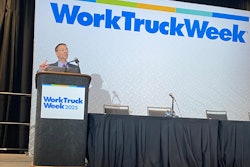We're only three months into 2025, and a strong contender for word of the year has already emerged: tariff. The Trump administration has at least twice already unfurled and then delayed new tariffs on certain goods and this week threatened to levy a new 200% duty on the European Union.
The supply chain is still working to prepare for potential tariffs on pretty much anything, and in this week's 10-44, we look at how motor carriers can prepare.
Contents of this video
00:00 10-44 intro
00:20 Tariffs and the supply chain
00:55 Using data to manage tariffs
02:16 Redesigning supply chain
04:43 Trucking and freight movement
06:29 Leveraging supply chain data
08:06 Minimizing the impact of tariffs
09:28 What can FourKites provide to fleets?
Speaker 1:
How the supply chain is reacting to President Trump's on again, off
Speaker 2:
Again tariffs. You're watching CCJs 10 44, a weekly episode that brings you the latest trucking industry news and updates from the editors of CCJ. Don't forget to subscribe and hit the bell for notification so you'll never miss an installment of 10 44. Hey everybody, welcome back. I'm Jason Canon and my co-host as always is Matt Cole. President Donald Trump. Last week, once again enacted 25% tariffs on goods from Canada and Mexico in an additional 10% tariff on goods from China before. Again, backing off and given everybody a little temporary
Speaker 1:
Relief. Even though the tariffs this time around don't apply to the big three automakers nor to goods covered by the United States, Mexico, Canada Agreement, at least until April 2nd, the supply chain is still working to prepare for potential tariffs on all those goods down the road.
Speaker 3:
All the interactions in the fortune that I have interacting with supply chain executive level down to director operational positions across supply chain and logistics, it purely is and has been the last six weeks, really a tariff war room type mentality that's been set in motion. So what that's set forth for every company, do I have the central data understanding of do I know what I do have within my commodities, within my part level details? Where am I going to be exposed on this tariff conversation if it does occur, as well as any determined length that it can occur. So the good part, regardless of the timing of tariffs being actioned or executed on pause that we are seeing as a pattern is it is forcing companies to make sure they have the right central data quality in place. So when they have that data quality in place, it is allowing them to collectively come together in those types of war rooms scenarios to make sure that yes, we have our tariff codes correctly identified, what is in scope and impacted. Then secondarily to that we know what inventory exposure we may have as well as the supplier origination point and the customer demand fulfillment opportunities to know should we action or look at a different supplying source
Speaker 2:
While one of the goals of the tariffs is to bring manufacturing back to the us, that doesn't happen overnight. So how will supply chains be impacted in the meantime?
Speaker 3:
So back to that context of now that I'm doing that analysis on where is my exposure in the data, now I can now approach two action plans. The first one is the immediate short-term understanding, which is to your point, it takes time to completely pivot a supplier base to a different region, takes time to set up a new logistics network in context to a different region. So the immediate thought today is, do I have the demand fulfillment customer demand that warrants me to go out and continue to do this importing, if you will, from APAC as an example, and that any tariff consequence associated with that can be off balance because you now have that outbound customer demand to validate that yes, we need to bring in that inventory. But the conditional part unto that as customers and demand us being consumers as well, we're also evaluating how we may change our buying spending patterns.
It really is a hard decision point that customers are making. Do I maybe pause some of that critical inbound inventory because I do expect a 10, 15% decline from the customers and then second to that, is there any chance I can pass on these tariff costs to my customer or alternatively back to my supplier? So that's really the short-term perspective that's being done. But the long-term perspective that companies are doing in parallel is they're starting to do those analysis strategies of can I redesign or augment parts of my supply chain network such as Nearshoring as an example, directly maybe into a region that isn't going through this tariff cross hairs right now that we're seeing. Or additionally, do I have capacity and expansion with maybe an existing manufacturing facility in the us? What would be the capital cost to bring in equipment, set that up and go through maybe a production manufacturing quality program to be able to provide that as a raw material here in the us. So in both cases, I always try to look for the good in scenarios. So from the short term to the long term, it is forcing companies to really evaluate their supply chain strategy, their supply chain execution, and to have this data to help them drive what's going to be the best fiscal responsibility decision for them.
Speaker 1:
So what does all of this mean for trucking and freight movement?
Speaker 3:
When you look at the context from a freight perspective, especially if there has been profitability through a lot of cross border capacity as well as rating across from the cross border perspective, is that you will naturally see is how can I as that carrier community, how can I be competitively different to pick up any capacity that may be available for maybe more dedicated in-country freight as an example. So I think when you look at that from the conversation of pivoting the specialized parts of a carrier trucking network into do they have more opportunity and more of a dedicated premium type service and that may offset some of what growth they have seen with cross border and international capacity in the last several years. I think additionally to that is you will commonly see, and it also happens typically when we're seeing spikes in the fuel surcharge arena is do I have the opportunity as we're still early in 2025 and March, a lot of the new bidding may be going forth this year with the respective carriers.
You typically try to protect yourself with some of the fuel surcharges, typically based on industry experts, predictions of consumption. If you tie that into, I think back to freight load capacity back into the market, as you could see some of those requirements coming into terms of agreement for the service is maybe I want to extend out a little bit longer. Instead of a six month term or a one year term contract, can we maybe get some agreement that we may commit to a little bit more of a longer term contract just to try to help preserve some of that, call it longer term revenue expectations
Speaker 2:
If April 2nd rolls around and tariffs go into full effect without further exemption, Steven explains how he sees it all playing out throughout the supply chain.
Speaker 3:
I think you'll see a very surgical approach touched in my near term comment a little bit earlier that the companies are now doing this analysis, they're guard railing their data, they can now put that data to customer demand validations. So I do expect in the short term that almost every supplier community is going out to their end customers and looking for that same type of mindset of four to five, six month agreements of firm forecasting to where we can go out and secure adequate supply as an example with these associated extra costs or maybe we bypass these tariff costs to make sure that we can at least go out here and try to function business as usual within our control as professional partners, whether a supplier, tier one, tier two, same conversation with the carrier community, let's be partners. That's why the more that we can leverage the centralization of data and use that data to help each party have transparency to what the reality is, it can really help save a lot of inefficiencies and help maybe avoid some of the excessive costs that we all realize are politically way above most of our pay grades and out of our respective control.
So I do look, use this data as a validator of reframing our working arrangement and framework, whether a supplier to a customer, whether a supplier to a carrier, in customer, to whatever method of transit they're looking for.
Speaker 1:
Steven says there are some things trucking companies can try to do to minimize the impacts of tariffs on their operations.
Speaker 3:
Currently here with Forkites and throughout my career, working with all types of logistic service providers across all parts of the globe, and there really is a sincere, genuine of being a partner to their end customers and making sure that that customer service, that white glove experience is hard to disassociate with. So I do share that into the context of even though there may be factors of let's say volume and capacity that can alter maybe rates they want that they agree to settle on or they look at ways to expand their business footprint that we mentioned, I do firmly believe from carrier's perspectives, they're doing that same type of internal detailed analysis on how can we go extend our footprint with premium customers that they have. Again, trying to forge that relationship. Let's be partners together in these uncertain times so that when things do calm down and we do see maybe some of that balancing intent of these global trade headwinds that we're observing, that it's our partnership that allowed us to each get through this with our reputations, with our trust unto one another that we're here to serve and fulfill what our customers want.
Speaker 2:
Steven talked earlier about the importance of understanding data when it comes to managing tariffs, which he now explains is one area Forkites can provide value to fleets.
Speaker 3:
We have, again, many partners within the trucking community that are customers of the Forkites Intelligent Control Tower and the forkites real-time network. And the one thing of that is just how data has always been used to validate the context of plan into the action into more of a performance context is everyone looks to ultimately satisfy their end customer. And so I give that context of just how carriers come to us to trust the context of data to help them better serve their customers as well as get better in their planning and transit routing process is that data, again, is going to be very paramount regardless of whatever routing strategy may routing strategy changes that may occur with their current customers. So again, here to continue that partnership and to continue to provide that transparency of the real-time connected data to drive that further action into accuracy.
Speaker 2:
That's it for this week's 10 44. You can read more on ccj digital.com. While you're there, sign up for our newsletter and stay up to date on the latest in trucking industry news and trends. If you have any questions or feedback, please let us know in the comments below. Don't forget to subscribe and hit the bell for notifications so you can catch us again next week.











